


Montreal’s got several nicknames, but the most interesting of them is probably City of Saints. It’s not because people here are so enlightened, although they are very friendly, as expected from Canadians (friendliness is their worldwide known brand). The nickname actually stems from all the streets bearing names of saints.
The city, with its European charm and North American flair, rich history, diverse culture, and captivating architecture, doesn’t have a nickname that reflects its gastronomic side, which is exceptional. Canadians love their food, and, with all the hard-working people forming the ancestry of those living in Montreal today, they enjoy recipes delivering on their promise, be it a full stomach, authentic taste, or sweetness to crown a meal.
This guide gives you 10 traditional Canadian dishes you can eat in Montreal. Not all of them are from Quebec – we have a dedicated article presenting those; rather, we’ve compiled a list that gives you an overview of the country’s culinary background. If, having read this piece and done a gourmet tour to Montreal, you come up with a gastronomic nickname for this city, do share it with us in the comments below.

This dish is one of the ingredients of the traditional Quebec breakfast. Creatons can be found on any restaurant menu. In fact, the dish is really simple, it consists of one single ingredient - minced pork, which is boiled in milk.
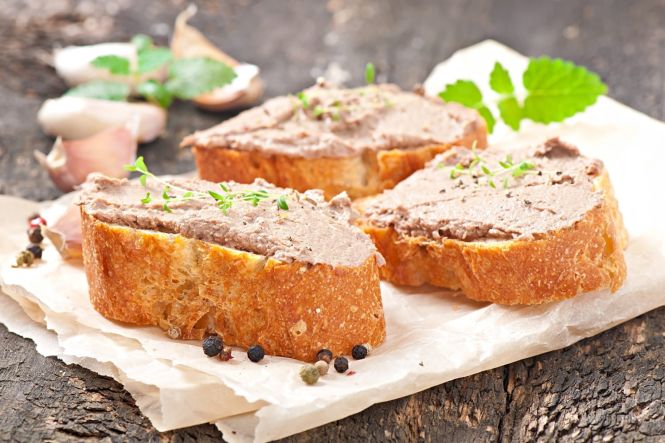 Cretons, traditional Canadian cuisine dish. Image by timolina, from Freepik
Cretons, traditional Canadian cuisine dish. Image by timolina, from Freepik
Since Canadian cuisine in general and its Quebecian branch in particular largely rest on the heritage of French settlers, you can’t say that the dishes listed in the local cookbooks are simple and efficient. Many of them actually require 20+ ingredients, dozens of steps, and hours of preparation. Yet, there are also such gems as cretons, obviously devised with simplicity and effectiveness in mind.
This spread is not unlike French rilletes. It is a matter of boiling pork shoulder (or leaf fat, as in the original recipe) in water or milk with assorted spices and seasonings until the liquid has evaporated, then putting it in the fridge for several hours for final solidification.The latter considered, cooking cretons may not feel that simple, but it’s a spread, so you make it once and for days, if not weeks, your breakfast with cretons on a toast is filling and nutritious.
One more thing: if the previous evening was fun enough for you to have a hangover, turn to cretons as a cure. Canadians believe eating a piece of bread with this pork spread on it is the best way to quickly get back in shape if you’ve had one too many the night before.
Universel Déjeuners et Grillades at 2055, Peel Street (or at 359, Saint-Catherine Street, this chain has two locations here) is a breakfast restaurant, according to the label on Google Maps. Thus, it’s a perfect place to eat Canadian cretons at, same as a number of other dishes typically consumed in the morning or for brunch. After your meal, you have a wide selection of museums to choose from, including the Montreal Museum of Fine Arts, Musée d'art contemporain de Montréal, Redpath Museum, and McCord Stewart Museum. All of them are within 10 minutes on foot from Universel Déjeuners et Grillades, and, since it is the Ville-Marie borough, Montreal’s ground zero (the city evolved from Fort Ville-Marie, a French settlement), the walk to any of them is an attraction in itself.

This is a meat pie that is a part of Christmas and New Year meals in Quebec (where it originated) and is sold all year long in Canada. It is made with minced pork, veal or beef and even fish in coastal areas of Canada. It is also a traditional French-Canadian dish.
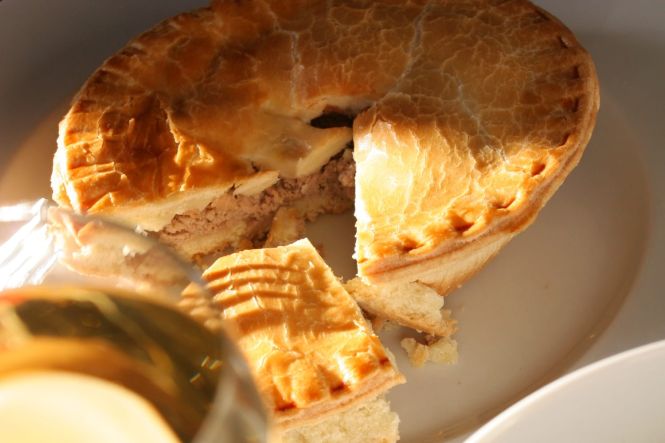 Tourtière, traditional Canadian cuisine dish. Image by Marc-Lautenbacher. Licence CC BY-SA 4.0. Cropped from original
Tourtière, traditional Canadian cuisine dish. Image by Marc-Lautenbacher. Licence CC BY-SA 4.0. Cropped from original
Pies, pasties, quiches and pierogies are arguably the most common dishes in all cuisines worldwide. There’s also flatbread, of course, thus the word “arguably” in the previous sentence; trying to tally up and compare the two requires a full-fledged research effort, and we’re not that nerdy a bunch here at Restaurant Guru.
Canadian cuisine has its share of pies, but the one loved the most is probably the double-crusted tourtière. Traditionally, it’s cooked for Christmas and New Year, a couple of holidays Canucks are especially fond of, thus the love. Or, perhaps, it’s a matter of consistency: the dish has been known since the 1600s.
It’s said that every family takes pride in its own recipe of tourtière, but they all have something in common. The dough is simple flour-and-butter, and the filling is ground pork, veal, beef, or game (or fish in coastal areas), plus optional mashed potatoes for stickiness. The set of spices, though, is a different matter, and this is actually what the ultimate taste of the pie hinges on. Given the wide range of respective options, truly unique family recipes of tourtière are more than possible, which justifies hunting for pieces of this treat through mom-and-pop bakeries of Montreal.
If you’re looking for a restaurant in Montreal that has locals as its target audience, come to La Binerie Mont-Royal at 4167, Saint Denis Street. The spot has been in business for years, offering all the staples of Quebec cuisine, including tourtière, so dear to Montrealers. Everything can be taken to go or enjoyed on the small but cozy floor. There aren’t many sights nor attractions around, so coming here may be an exercise in getting to know the regular, non-touristy vibe of the City of Saints, which is a mandatory part for anyone seeking a 360° experience thereof.

It consists of French fries and cheese curds with light brown gravy on the top. This is a fast-food dish usually offered in small diners, pubs, roadside chip wagons and hockey arenas. It originated in rural Quebec in late 1950s.
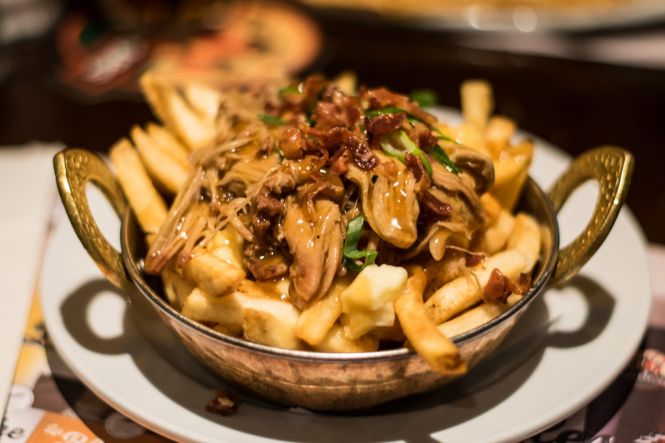 Poutine, traditional Canadian cuisine dish. Image by 0x010C. Licence CC BY-SA 4.0. Cropped from original
Poutine, traditional Canadian cuisine dish. Image by 0x010C. Licence CC BY-SA 4.0. Cropped from original
Can a fast food dish become a national cuisine staple? It’s usually the other way around, i.e., recipes that have been there for years/centuries end up being somewhat optimized and turned into items on the menu of a chain eatery, like pizza, tacos, and all sorts of fried chicken. However, there are such cases as poutine, a meal utterly fast food and yet a definitive Canadian cuisine highlight.
Poutine is a rather recent invention: several Quebec villages compete for the title of birthplace of the recipe, and they all agree it appeared in the late 1950s. The dish itself is very simple: French fries, curds, and some moderately hot gravy based on meat. The ascent of poutine to Canadian culinary stardom was quick; today, you can find it in virtually every outlet of every fast food chain of the country, as well as in countless diners, pubs, road houses, and hockey arenas.
Canadians can make simple things complicated: if you’re looking for a non-traditional version of poutine, seek out a shop of the Smoke’s Poutinerie chain. There, they’ve turned this food into a form of art and, as of this writing, carry over 30 gourmet varieties of poutine.
Looking for an authentic diner experience that’s soaked in the North American flair we’ve mentioned in the intro? Come to Greenspot Restaurant – Smoked Meat – Breakfast – Burgers at 3041, Notre-Dame Street. The name of this establishment gives out the highlights you can eat here, but the menu has more items deserving your attention, and poutine is positively one of them. At this place, they make it with fries cut bigger than usual, a solution probably rooted in the experience, since this eatery was opened in 1947. This sort of longevity is a reason enough for a visit, but it’s not the only one: the entire Saint-Henri neighborhood where the restaurant is located is packed with sights, parks, and attractions.
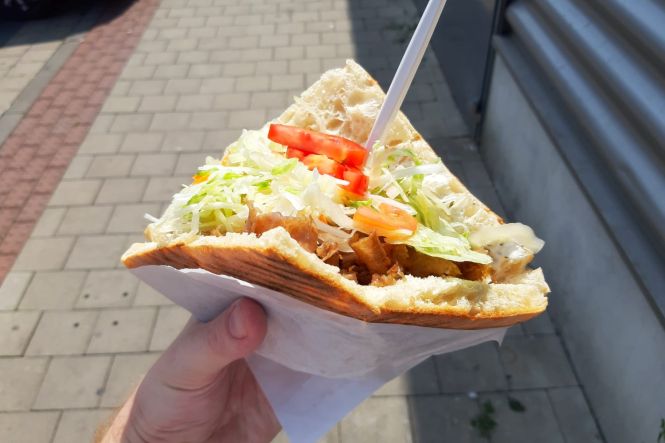 Donair, traditional Canadian cuisine dish. Image by GALAXY 2018 A7. Licence CC0. Cropped from original
Donair, traditional Canadian cuisine dish. Image by GALAXY 2018 A7. Licence CC0. Cropped from original
Everybody loves doner! This street food, which many consider German, is actually a distinguished and old dish from the Ottoman Empire, i.e., Turkey of the 19th century, where it was called döner kebab. Nowadays, stalls selling these meat-filled rolls can be found in all major cities of Europe and North America.
In Canada, though, you may be slightly confused upon encountering “donairs.” Is this a typo, or a special Canadian variation of döner? No and no. The name, it seems, was coined to deliberately resemble that of the Turkish-German staple, but the essence of this dish is Greek, same as its inventor. The story goes about a Greek immigrant, Peter Gamoulakos, who launched a gyro shop in Halifax in the 1950s. Locals, however, found what he offered somewhat unappealing. Not easily discouraged, Peter did some research and came up with donairs, a rolled pita bread filled with tomatoes, onions, meats (all chopped), and a somewhat sweet sauce. This one took off; today, donairs aren’t exclusive to Halifax, although, for the sake of simplicity, some places label them as variations of döners or gyros.
How do you tell the difference? First off, the sauce, which, as mentioned above, is on the sweet side, and secondly, the size. Donairs can weigh up to a kilo, so don’t approach one unless you hear your stomach cursing you for keeping it empty that long.
One of the reviewers described La Ligne Rouge as a hole in the wall place, which means it’s small, low-key, and inexpensive. All three adjectives apply to this spot, plus another one: delicious. The food they make here, including donairs, is so good you won’t notice the barebones interior after the first bite. So, if you plan to see Castelnau Square, or Dante Park, or Little Italy, consider dropping by La Ligne Rouge.

This is a classical Québec dish which means 'boiled'. It's cooked slowly with cuts of beef, bacon and vegetables like potatoes, carrots, turnips, onions, white beans and cabbage. It’s usually regarded as a winter dish.
 Bouilli, traditional Canadian cuisine dish. Image by freepik, from Freepik
Bouilli, traditional Canadian cuisine dish. Image by freepik, from Freepik
Stews usually start out as food for the poor, since they allow putting together whatever is at hand in a hearty dish, which, thanks to spices and seasonings, can also be tasty. This latter fact, when the combination is especially successful, pushes stews up to the top positions among national cookbook gems. For Canadians, this is the story of bouilli.
It has a predecessor in French cuisine, pot-au-feu. Nowadays, the name can be used as a collective label for stews in France, but the interesting thing about it is the direct translation, which is “the pot is on fire.” The differences between Canadian bouilli and French pot-au-feu are in the choice of meat, with the former incorporating pork and lard and the latter usually including beef exclusively, and vegetables, although it actually varies widely inside the respective nations, too.
The secret of good bouilli, or any pot-au-feu/stew, is to let the contents of the pot simmer, not boil, regardless of the name. Making this dish in a regular cookware and not a pressure cooker, it’s best to put the lid on in a way that leaves a little crack, which lets the excess heat escape. This approach guarantees proper simmering.
Hoogan et Beaufort is a restaurant that prides itself on cooking from locally sourced, always fresh ingredients. In fact, the name of the place consists of surnames of two farmers who founded it. There’s a drawback to this concept, though: the menu is not set, it changes with seasons, following availability of components of the dishes served. But, given the versatility of the recipe, bouilli is a mainstay, so drop in for a bowl thereof, and some fine wine, too.

This dish is a variety of wood-fired baked bagels. They are small, sweet and dense with a large hole in the middle. The main rule of its preparation sounds like that: it is always baked in a wood-fired oven. This dessert was brought by Jewish immigrants from Poland and, thus, each of the variants you may come across reflects a certain area in the home country.
 Montreal-style bagels, traditional Canadian cuisine dish. Image by freepik, from Freepik
Montreal-style bagels, traditional Canadian cuisine dish. Image by freepik, from Freepik
A brunch in Montreal? Or an afternoon snack, maybe? Why, Montreal-style bagels, of course! The City of Saints has a number of ultra-local treats, and this pastry is probably the best known of them, to the point of being labeled one of the national cuisine staples.
So, what’s so special about Montreal-style bagels?
– They are smaller, denser, sweeter than their popular siblings, and have a larger hole in the middle.
– The dough is flour, malt, and egg, and they are boiled in honey-sweetened water prior to baking.
– They are baked in wood-fired ovens exclusively, otherwise, it’s not the real deal.
There are two core varieties of Montreal-style bagels, one with poppy seeds on top and the other with sesame seeds. Same as famous NYC bagel, the pastry was brought to Montreal by Polish Jews; the two bakeries established in partnership with Chaim Seligman, who was the first one to make these now-iconic buns in Montreal, are still in business, so you can enjoy bagels (and coffee) in both of them.
The two original Montreal-style bagel bakeries mentioned above are Fairmount Bagel at 74, Avenue Fairmount, and St. Viateur Bagel Shop at 263, Rue Saint-Viateur. The former was established in 1919 (its logo presumably depicts Chaim Seligman himself), the latter – in 1957. The spots are only 750 m away from each other, this is a 10-minute leisurely walk, so, naturally, we suggest you eat bagels at both outlets and see for yourself which of them does a better job.

It is of the French-Canadian origin and is of medium density. It is recommended to be prepared in a pressure-cooker. The color of the soup is very appealing.
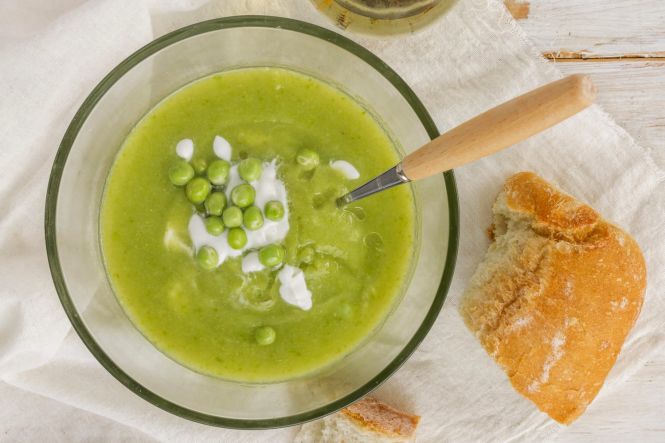 Split pea soup, traditional Canadian cuisine dish. Image by freepik, from Freepik
Split pea soup, traditional Canadian cuisine dish. Image by freepik, from Freepik
Humankind has been farming legumes since times immemorial. The first evidence of beans used as food is over 6,000 years old. Varieties of this crop are grown everywhere on the planet except Antarctica; nutritionally, it’s a great source of zinc, iron, prebiotics, and protein (thrice as much as in cereals). If you’re looking for a superfood bearing this label justly, it’s legumes.
Canadian split pea soup belongs to a larger domain of legume-based dishes that began to take shape in Ancient Greece, where first recipes revolving around this ingredient were compiled. This particular meal has been in Quebec cookbooks for over 400 years now; currently considered to be comfort food for winter days, it used to be the key source of sustenance for hard-working settlers.
Today, you can eat split pea soup, a blended puree with pork, potatoes, and herbs, in most restaurants of Montreal carrying national cuisine dishes on their menus. Do have a bowl even if you visit the city in summer; it’s got something that conveys the very spirit of Canucks.
Looking for some fine-dining experience in Montreal? Consider reserving a table at Restaurant Bonaparte, open for you at 447, Saint Francois Xavier Street. This place offers Quebec and French cuisine classics (including split pea soup, which may have a twist expressing the chef’s attitude towards the dish), and you get to eat them in interiors designed to bring you to Napoleon’s time. A visit here may require more than one hour, so plan your evening accordingly.

This dish was called ‘a pudding for the poor’. It was created in Quebec by factory workers in 1929 during the time of depression. Mix flour, water, brown sugar and other not so expensive ingredients - and the cake is ready. In the 21st century, a creamy sauce made from the maple syrup is also added.
 Pouding chomeur, traditional Canadian cuisine dish. Image by KamranAydinov, from Freepik
Pouding chomeur, traditional Canadian cuisine dish. Image by KamranAydinov, from Freepik
Literally, “pouding chomeur” means “pudding of an unemployed man,” which points to the fact that it was one of the very few sweet treats available to the unprivileged. Poor man’s food often grows into something loved on a national level, as mentioned in the bouilli section above, but such a transformation is not exactly common among sugary dishes, which makes this Canadian dessert a somewhat special case.
There are two pouding chomeur origin stories. Both point to the Great Depression and Quebec factories as the time and place of invention of the recipe, but they differ in the core ingredient: the first states the cake was made with flour as its base, the second has stale bread in this role. Caramel of melted sugar is a shared component.
Today, pouding chomeur is no longer reserved to the poor or the unemployed. A rather refined and very popular dessert that belongs with other Canadian cuisine staples, it is made of sponge cake batter covered with Canadian maple syrup or caramel before baking. Pouding chomeur is a traditional treat during saison des sucres, the time of the year when maple sap is collected, but cafés and restaurants of Montreal don’t limit themselves to this period and serve the cake all the year round. Enjoy!
A heated terrace, and a jazz trio jamming live, all in one place? This is Jardin Nelson, a lively restaurant located at 407, Pl. Jacques-Cartier, around the corner from Montreal City Hall. Le Vieux Montréal, the ferris wheel that is a must-ride for any tourist, is also right here, 5 minutes on foot from the dining establishment, so you’ll be in the neighborhood for sure. Having enjoyed a meal at Jardin Nelson – try salmon lasagna, it is a rather rare dish – complete your evening with pouding chomeur, which is one of the highly praised highlights of the menu.

It’s a dessert that needs no baking. It was named after the city of Nanaimo. There exist many varieties of this dessert, but in general they all are made of a wafer crumb-based layer covered with icing which is topped by melted chocolate. The first mentionings of the dessert are found in the Edith Adams’ prize cookbook.
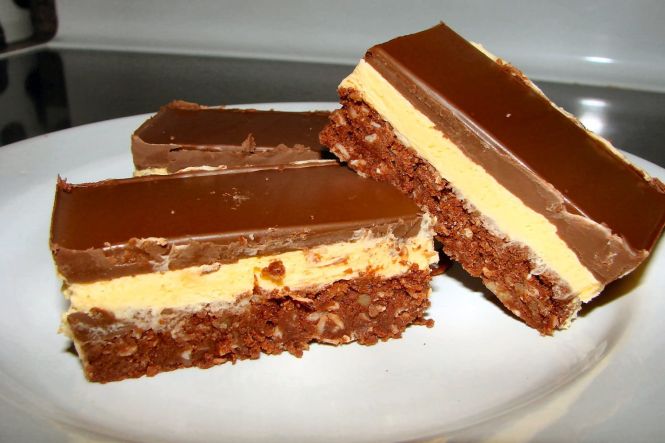 Nanaimo bars, traditional Canadian cuisine dish. Image by Sheri Terris. Licence CC BY 2.0. Cropped from original
Nanaimo bars, traditional Canadian cuisine dish. Image by Sheri Terris. Licence CC BY 2.0. Cropped from original
Nanaimo bars, obviously, have been named after the city of Nanaimo, which is in Canada’s British Columbia. Their exact origin is unknown, but one of the earliest editions of Edith Adams’ Prize Cookbook (1930s) had the recipe of these sweets.
In the more or less classic form, the three layers of a Nanaimo bar are wafer, a mix of coconut crumbs and walnuts/almonds/pecans, and chocolate-based cream on top. They are not baked but solidified in the fridge; made and sold by many confectionaries, these treats come in numerous varieties.
Canadians love their Nanaimo bars: in 2019, Canada Post released a set of stamps that honor these delights, along with other desserts and sweets populating the sugary section of national cookbooks. Eating one while in Montreal (or anywhere else in Canada) is a must, even if you haven’t got a sweet tooth.
Chocolats Favoris is a chain of chocolate shops with 10 outlets in Montreal, as of this writing. You can drop in for a nanaimo bar and coffee in any of them, the quality, praised in numerous glowing reviews, is similar everywhere, which is quite expected from a business that’s already done a good job in terms of expansion and is looking to march on. The spot we suggest is at 150, Saint-Catherine Street; it is downton Montreal, so it may be crowded come evening, but this sort of attention also means you always get your order as fresh as possible.

This dessert is considered one of the quintessential Canadian ones. The tarts are eaten in English-speaking provinces of the country. The first recipe is dated 1900. It was an integral part of the early Canadian cuisine and a source of pride.
 Butter tart, traditional Canadian cuisine dish. AI-generated image
Butter tart, traditional Canadian cuisine dish. AI-generated image
There’s a beautiful story about the origin of butter tarts, one of the most loved Canadian desserts. It involves three young maidens who happened to be daughters of the King; in the 17th century, these filles du roi were sent to Quebec, where they adapted the tart recipe known to them to the ingredients available. Thus butter tarts were born.
The traditional way of making this dish prescribes taking a crusty pastry shell, pouring mixed butter, egg, sugar, and syrup into it, and baking until the top of the filling is almost solid. Today, Canadian pastry chefs often get inventive in their interpretations of this classic, making it not sweet but savory with the smell and taste of bacon, or poutine (see above), or even ginger and miso.
While encouraging trying all sorts of butter tarts you come across while in Montreal, we suggest putting the time-proven variant on the must-eat list. Make it two, in fact, one with raisins and another without them, since there’s an ongoing debate about whether these dried grapes should complete this pastry or it's already perfect as is.
It’s really not easy to pick just one bakery, café, or restaurant to suggest as the place to eat Canadian butter tarts at in Montreal. They are quite common throughout the city, so, for a gourmet, it would be a wiser decision to take one whenever it’s encountered in an establishment you’ve come to for a meal. If you happen to spend time in La Fontaine Park – a prominent patch of greenery with a couple of ponds – then it makes sense to find Boulangerie les Co'pains d'abord at 418, Rue Rachel. Their pastries, including butter tarts, are simply outstanding.
Montreal is a magnificent destination even without its culinary wonders. You can feel that locals really love their city, same as their predecessors, down to the daring people who settled here first. For a gourmet, though, the picture is only complete if sights and attractions are alternated with tasty breakfasts, lunches, and dinners. We hope this guide helps you plan what to eat in Montreal to make the trip thereto memorable by all accounts. For more advice, see these Restaurant Guru’s articles:
– 10 typical Quebec dishes to try in Montreal, Canada
– Exploring Canada: Montreal's top restaurants you cannot miss
– Explore the best food spots in Montreal, Canada
– Your food & travel guide of magical time in Montreal, Canada

1 comment
I visited Montreal once and loved exploring all the streets with names of saints, giving the city its nickname. The food in Montreal is so delicious, especially the traditional Canadian dishes like Cretons - perfect for a filling and nutritious breakfast!